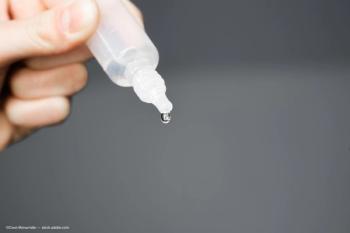
Fixed-combination glaucoma agent yields positive safety, efficacy data
A phase III trial for the fixed-combination netarsudil/latanoprost agent (Roclatan, Aerie Pharmaceuticals)reports positive results. The company plans to submit a NDA for the drug in early 2018.
Reviewed by Robert Fechtner, MD
Twelve-month safety results and efficacy levels were reported recently for the Mercury 1 phase III registration trial for a fixed-dose combination of netarsudil ophthalmic solution 0.02% and latanoprost 0.005% (Roclatan, Aerie Pharmaceuticals).
Mercury 1, a 12-month safety and efficacy trial, included a 90-day efficacy endpoint and was created to gather sufficient safety data to submit a new drug application (NDA) to the FDA in early 2018, according to a prepared statement from the company.
Mercury 2 is a 90-day efficacy trial and had results reported in May. A third trial called Mercury 3 will be performed in Europe in the third quarter of 2017.
The drug combines netarsudil (Rhopressa, Aerie Pharmaceuticals) with the prostaglandin latanoprost. The product is intended for once-daily use.
Primary endpoints
Both the Mercury 1 and 2 trials met their 90-day primary efficacy endpoints that demonstrate statistical superiority over each of its individual components at all measured time points. The study also measured IOP at 8 a.m., 10 a.m., and 4 p.m. at 6, 9, and 12 months. Patients included in both trials had maximum baseline IOPs ranging from above 20 mm Hg to 36 mm Hg.
If approved, the agent would be the first glaucoma product to lower IOP through all possible mechanisms, including the increase of fluid outflow through the trabecular meshwork, the increase of fluid outflow through the trabecular meshwork, the reduction of fluid production in the eye, and the reduction of episcleral venous pressure, the company noted.
“By covering the full spectrum of known IOP-lowering mechanisms, [the drug] has the potential to provide a greater IOP-lowering effect than any currently approved glaucoma product,” according to a press release from the company.
If approved by the FDA, the product could be a welcome addition to the glaucoma armamentarium, said Robert Fechtner, MD, professor and chairman of ophthalmology, State University of New York, Upstate Medical University, Syracuse, New York.
“Rock inhibitors have been a long time coming,” he said. “With any new class of medications, we always hope to learn as much as we can about what to expect before we start using it in our patients.”
One positive factor from the recent data is that there are 12-month results versus results for only 3 to 6 months, Dr. Fechtner said.
“This is the first prostaglandin fixed-combination that appears to demonstrate superiority to latanoprost alone at all time points,” he said. “The prostaglandin beta-blocker fixed-combinations available elsewhere in the world did not get approval in the United States. We are still waiting for a prostaglandin fixed combination.”
If or when the agent becomes available, it would give an additional once-daily, single-bottle option besides prostaglandin alone to offer patients, Dr. Fechtner said.
Safety, adverse events
No new adverse events occurred during the 90-day reported period for Mercury 1. Hyperemia did occur in 60% of patients. Most of those cases were mild as determined by biomicroscopy. The hyperemia that occurred was sporadic.
“Hyperemia is a common adverse effect and was slightly more frequent at 12 months (63%) than at 3 months (55%),” Dr. Fechtner said. “For reference, hyperemia was reported in 21.9% of subjects using latanoprost.”
The other adverse events observed during the 12-month trial are consistent with those observed during the initial 90-day efficacy period, including conjunctival hemorrhages and corneal verticillata, according to the company. The occurrence of corneal verticillata, or vortex keratopathy, also has occurred in patients using systemic medications like amiodarone and subconjunctival 5-fluorouracil as an adjunct for glaucoma surgery, Dr. Fechtner said.
“This is a new adverse effect for an IOP-lowering medication, and the long-term implications are not yet known,” he continued.
In 60% of patients, the drug reduced the mean diurnal IOP to 16 mm Hg or lower-a significantly higher percentage than what was observed in the two comparator arms.
The company submitted an NDA for netarsudil (Rhopressa) in February 2017. The FDA has stated that its goal date to complete its review of netarsudil is by the end of February 2018.
Although the results from netarsudil/latanoprost (Roclatan) are positive, Dr. Fechtner would like to know more about the agent, such as how many real-life patients will not tolerate it due to adverse events and the effects of additivity of other single agents or fixed combinations to the drug.
Robert Fechtner, MD
Dr. Fechtner is a consultant or provides research support for Aerie Pharmaceuticals, Alcon Laboratories, Allergan, Bausch + Lomb, Novartis, and Santen.
Newsletter
Don’t miss out—get Ophthalmology Times updates on the latest clinical advancements and expert interviews, straight to your inbox.















































